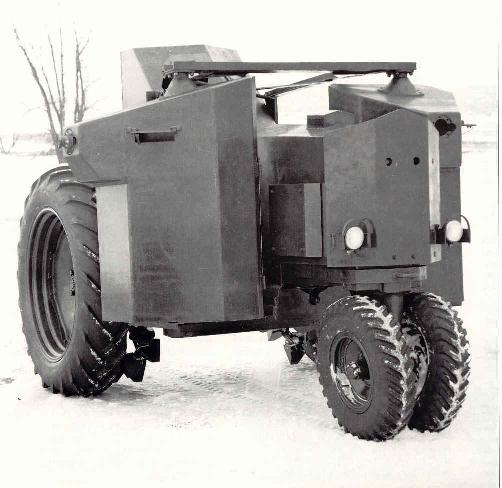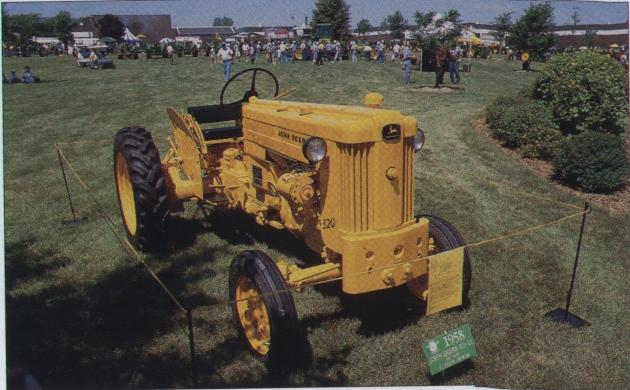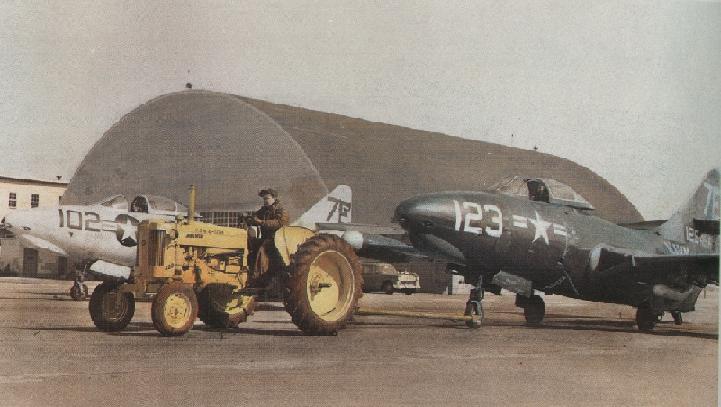Tractors serving in the U.S. Military
| Warning The below document is classified: TOP SECRET You are not cleared to study the material below, if: 1.You are a Farmall, or other off-brand owner. 2.Have even THOUGHT of owning off-brand tractors If you violate the above restrictions, you may still view the material, if and only if, you send $500 in unmarked bills to the webmaster If you meet the above restrictions, you may PROCEED |
John Deere doesn't seem to have been a very popular military tractor in the two cylinder days. Wheel tractors weren't too popular for combat/forward deployment work, due to the fact that shrapnel can get rid of tires in seconds, and crawlers are usually more sure-footed. This made types, such as Caterpillar and Cletrac very popular. Deere, had only a handful of crawler types (comparatively), and Caterpillar and Cletrac certainly had more experience in the crawler field, plus a wider range of sizes/types. John Deere even produced Cletrac MG-1s during the war to supplement the Cletrac production. This was a common practice between manufacturers during the war.
There were times where crawlers weren't as suited for the job-such as work on concrete airfields, or mowing around installations (Although, rubber tracks could be fitted. I have seen a military Cletrac on rubber tracks, for moving aircraft, clearing wrecks, etc.) Even for these jobs, Deeres weren't popular. I've seen (in pictures, and personally) military versions of wheel Minnieapolis Molines, Cases, and others. Yet, very few Deeres.
However, Deere did TRY to get tractors into the military-some examples that I have found are below.
Note: You may notice, on military tractors of all brands, there are usually big brass plates on the tractor, near the operators position. These plates included operating information, maintenance instructions, etc, so P.F.C. Gomer Pyle wouldn't destroy a tractor on its first day of use.
The BO crawler
During World War Two, Jesse Lindeman (designer of the crawler) delivered 3 crawlers to the Army, for possible use. They had a blade that was lifted/lowered by power from the belt pulley. This blade was also able to change from a flat blade, diagonal blade, or V-blade by removing one pin!
The Army rejected the design...
Lindeman then repainted two of the returned crawlers, and presented them to the Navy. The crawlers were tried, at least one with a scoop shovel.

The Navy rejected the design...
Finally, Lindeman built about 12 crawlers on rubber tracks. These were used to clean scrap steel from ship's holds. The rubber tracks kept the decks (floors!- ye landlubber!) of the ships from being damaged.
Source: John Deere Farm Tractors
An Armored Model A

Second try...The stacks are gone now. Notice the steel wheels! The right side gun turret is facing to the side. Here come the Hatfields and McCoys!
There was a "Armored" Model A prototype, tested just prior to the U.S. entry in World War Two, in early 1941. It was a normal tricycle A, fitted with plate steel to simulate armor plate. It also had two hydraulically driven turrets that housed a single machine gun each (looks to be .30 caliber). It had a full set of rubber tires, front and rear. However, in the rear, beside the rubber tires, there was also a set of steel wheels with lugs-"to help traction in loose soil".
Various problems were found with the arragement, including major instability, and some visibility problems. The air intake and exhaust stacks were removed, and eventually a wide front axle was fitted. It was also found that the steel wheels were a problem at high speeds on paved surfaces. The tractor would bounce enough for the lugs to dig into the pavement! The steel wheels were removed.
It was thought that the "A" could have been used as a temporary combat unit, an armored "prime mover", or trainer for tank crews, but none of these uses came about, and the various prototypes were most likely scrapped.
Most of the information was found in Two-Cylinder Magazine from September-October 1993. The picture is also from that article. I could include more, but I think I've stolen enough.
The 320

A 1958 320U that served in the military. It has a lift loop, and specification plates (for instructing personnel). Plus what looks to be a pretty big generator, but this may be a retrofit.
Source: Two Cylinder Magazine
The 420

A 420I being used by the Navy to tow a Grumman F9F Cougar on the ramp. Its location is the Naval Air Reserve Station at Wold-Chamberlain Field during 1957. This location is more commonly known as Minneapolis, Minnesota.
Source: How Johnny Popper Replaced the Horse
Cross back into friendly territory, and go back to Two Cylinder Home
Or continue into enemy lines, at www.cletrac.org
Yet another note: The above page contains many stupid jokes, and if you are insulted because you own a so called off-brand tractor, CALM DOWN! It's a joke! Just remember, I, the webmaster, own an Oliver 70, and I enjoy playing with our Case VAC. Except, I don't owe myself $500!
If you can help with information on this page, email me at moparwhs@hotmail.com